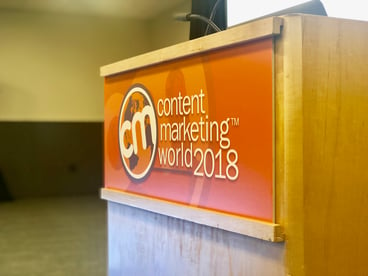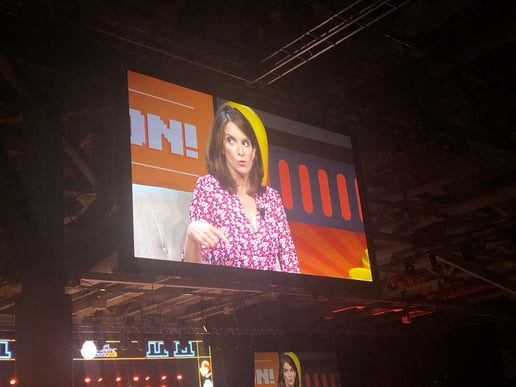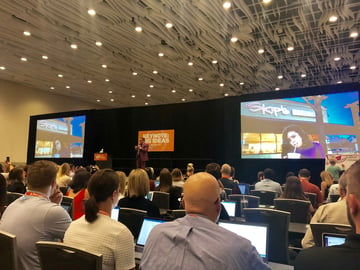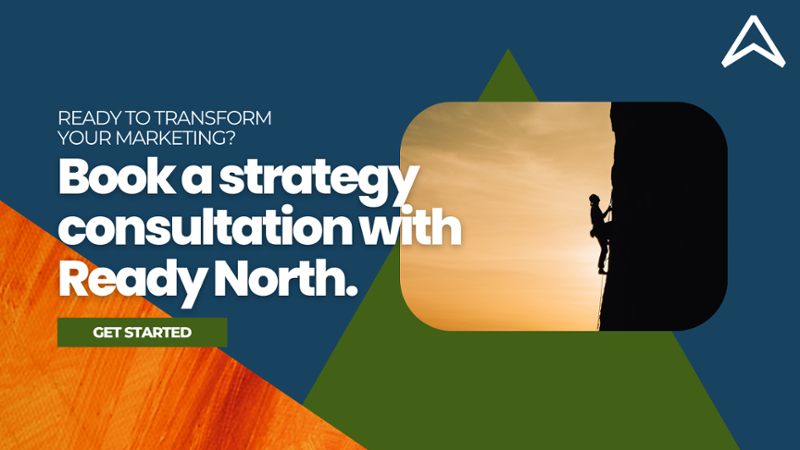 It’s that time again… welcome to the kickoff of marketing conference season!
It’s that time again… welcome to the kickoff of marketing conference season!
Every year, a handful of PR 20/20 team members head to Content Marketing World (#CMWorld) hosted in our very own Cleveland, Ohio. CMWorld is the largest content-focused event of its kind, bringing together 4,000+ marketers to learn the tools and materials needed to build the best content marketing strategies.
Attendees get access to some of the top industry influencers and keynote speakers (who agrees that seeing Tina Fey speak gives us serious bragging rights?!).

This year’s event offered a wide variety of topics organized into tracks like content strategy, search and data, process and workflow, demand generation, visual storytelling, content distribution, teams and culture, and much (much!) more.
Did you miss this year’s Content Marketing World (or suffer from information overload)? Continue reading as we share our top lessons learned at this year’s event.
1. Our audiences will make time to consume content that both grabs and holds their interest.
Are you a marketer who understands that your audience has the attention span of a goldfish?
All too often, we hear that our audiences don’t have time to read the blog posts, ebooks or emails we create. As a result, we’re making our content shorter and shorter in hopes that visitors will stick around and read it. At what point, though, does it become so short that it lacks any element of interest? Perhaps it’s not that our audience doesn’t have time, but that we as marketers are not creating content that sparks curiosity.
As bestselling author and influencer Andrew Davis (@DrewDavisHere) explained in his first-day keynote session, “Our audiences will make time to consume content that maintains their interest.” Davis went on to explain how marketers can cut through the saturation of content that already exists to both grab and hold our audiences’ attention. This includes:
- Create a curiosity gap, or a space between what our audience already knows and is seeking to know.
- Add payoff to your content that is proportional to the tension that you build throughout.
- Raise the stakes. Tease what the audience wants to know and “threaten” it as long as possible to hold attention.
2. The most successful marketing teams break down silos and foster collaboration.
.jpeg?width=367&name=20951FEF-41AA-4EE4-9542-C40ECA2C790E%20(1).jpeg) Why is it that marketing teams work in silos? Instead of working towards one common goal, we often see that teams are broken into channels (content, social, paid, SEO, etc.) and are pitted against each other, rather than rallying together. But how does this achieve anything (outside of unhealthy competition)?
Why is it that marketing teams work in silos? Instead of working towards one common goal, we often see that teams are broken into channels (content, social, paid, SEO, etc.) and are pitted against each other, rather than rallying together. But how does this achieve anything (outside of unhealthy competition)?
Founder and CEO of NewsCred, Shafqat Islam (@shafqatislam), made it clear: better teams = better content.
Easier said than done? Not when teams work together to break down silos, embrace adaptability and focus less on competition across channels or departments and more on collaboration as one, unified team.
Islam explained how the NewCred team lives out this ideal by:
- Facilitating frequent cross-company dialogue and information sharing.
- Creating cross-channel functional plans.
- Enabling real-time, global visibility into feedback, status and performance of plans and campaigns.
- Moving seamlessly from planning to execution (ex: NewsCred doesn’t let plans live in static spreadsheets or PowerPoints that die in someone’s inbox).
- Increasing collaboration to produce and repurpose more high quality content.
Islam finished his session by reinforcing the importance of teams that work together: “Every time you give teams a high degree of trust and common purpose, they create really beautiful things. This is worth doing in marketing. If we can do our jobs, we can create opportunity."
3. Content creation may be king… but promotion is just as important.
We’ve all heard the adage: Work smarter, not harder. This thought process certainly applies when it comes to content marketing.
This was the theme during the session by Ian Cleary (@IanCleary), founder of RazorSocial. Cleary recommends following the content promotion spire to ensure your content creation hard work pays off:
- Target a topic. Pick a topic with good keyword volume and ensure it’s helpful and useful to your target audience. Look for opportunities to create content pillars and topic clusters to support each.
- Create the right content. Your content needs to have a unique angle to break through the clutter. Consider older pieces of content that you can update and repurpose to get more views, links and shares.
- Build content media. Instead of throwing text-heavy or dense topics right at your audience, break up longer pieces to make them more interesting and readable. For instance, break up texts with images and videos, or pepper in visual elements like designed quote boxes, stats or key points throughout.
- Outreach. Make it easy for readers to share and enjoy your content. Reach out to your community before a post is published to offer feedback or pre-promote. Target key contacts with relevant content during email promotion and monitor keyword mentions to get the most leverage.
4. Give customers a story worth telling with “talk triggers.”
 According to Jay Baer (@jaybaer), “The best stories are about what you DO, not about what you SAY.” In other words, word of mouth + content = customers growing your businesses. Now more than ever, customers have the power to drive sales and the overall success of a business. In fact, more than 50% of purchases are made primarily by word of mouth.
According to Jay Baer (@jaybaer), “The best stories are about what you DO, not about what you SAY.” In other words, word of mouth + content = customers growing your businesses. Now more than ever, customers have the power to drive sales and the overall success of a business. In fact, more than 50% of purchases are made primarily by word of mouth.
So how can marketers leverage this information to drive sales for the businesses they promote?
Too often marketers focus on finding influencers within their industry, and try to duplicate or mimic their ideas, campaigns, etc. But, what we really should be focusing on is finding out what will make your company stand out amongst the rest. This can be done with “talk triggers,” also known as strategic choices that compel word of mouth.
When creating “talk triggers,” keep the following in mind:
- Remarkable. Same is lame. Following top industry leaders is not always the best option. Focus on making a splash for your brand with something people will remember.
- Repeatable. Contrary to belief, surprise and delight is a stunt, not a strategy. Pick something that works for your company and do it over and over again. Baer used the example of DoubleTree, which gives warm chocolate chip cookies to every single guest that checks in, and people remember this touchpoint about their brand.
- Reasonable. Experiences that are too grand create suspicion. Focus on being different enough to be talkable, but not so big that it’s not trusted by customers.
- Relevant. Your content must have context. Think about who you are and what you are about. Focus on delivering one of the four types of “talk triggers:” generosity, responsiveness, usefulness and attitude.
As Allison Melnik (@AllisonMelnik) says, “Marketers need to focus on how they can make brands stand out to not only make consumers remember who they are, but want to choose them over and over again.”
5. Email is not just alive and well, but it’s the backbone of content marketing.
Despite what hundreds of blog posts and news articles have said about email, it’s not dying. Similar to long-form content, only bad and uninteresting email marketing might as well be dead.
In fact, a report from VentureBeat shows that those who invest in email marketing earn $38 for every $1 spent—talk about good ROI.
Why does this channel, which existed before the internet, still work so well? As Ann Handley (@MarketingProfs) pointed out in her keynote session, “Email is the only place where people (not algorithms) are in control.” With other digital channels—Facebook, LinkedIn, paid search, organic search, PR—someone else has the final say in the who, when and where of your content exposure.
With the opportunity to completely orchestrate delivery through this channel, how will you leverage that power? The purpose of email marketing is to create a loyal audience (through a subscriber base) and deliver on it.
In particular, email newsletters present huge potential—and outperform single mailings alone. Handley’s keynote gave us three keys to success with newsletters:
- The most important part of the newsletter is the letter. The news may be what makes someone initially subscribe, but the letter is what makes it stick. Deliver it. And deliver it consistently.
- Write to Doris. Annually, Warren Buffett’s Berkshire Hathaway shareholder letter is sent to thousands of investors and read by hundreds-of-thousands more. But, what makes his stand out amongst the others is their personality. The trick (and it’s really not a trick), according to Buffett, is that he writes each as if it’s addressed to his sister, Doris. Think about it, email is consumed personally. Identify your Doris, and write your email is if she is your only subscriber.
- Develop your tell. To expand on the concept of writing to Doris, develop your tell. Like a bad poker player has a give away that signifies to the other players of a good hand or a bad hand, a good email marketer has a personal tell that shows his audience it’s uniquely you. A tell conveys that the email could only come from you.
To sum it up, Tim Anderson (@TimetoAnderson) says, “Before you ditch email to focus on other marketing channels, consider how consistent, personal and authentic emailing could build the audience that becomes the backbone of your content marketing efforts.”
Subscribe for more marketing goodness.
Be the first to know about the the latest marketing news, tips and best practices. Subscribe to our blog.

%20Logo_BlueOrange_Trademark.png?width=800&height=269&name=Ready%20North%20(RN)%20Logo_BlueOrange_Trademark.png)




.jpg?width=300&name=Services%20Hub%203%20(3).jpg)


